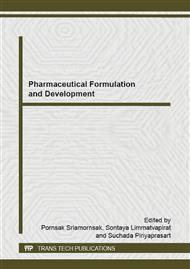p.107
p.111
p.115
p.119
p.124
p.128
p.133
p.137
p.141
Comparative Molecular Similarity Indices Analysis Studies on Chromone Derivatives as Topoisomerase I Inhibitors
Abstract:
DNA Topoisomerase I is an enzyme, which is involved in DNA replication, transcription and chromosome segregation in cellular processes. Inhibitors of Topoisomerase I are designed to interrupt DNA replication in cancer cells, resulting in cell death. The goal of these studies was to identify structural features necessary for increasing inhibitory effect of Topoisomerase I and further use these features for designing novel anticancer agents. 3D-QSAR method was performed for 15 chromone derivatives using Comparative Molecular Similarity Indices Analysis (CoMSIA) method. The best CoMSIA model was obtained from AM1 geometry optimization and align database alignment. The satisfactory CoMSIA model based on steric, electrostatic, hydrophobic and hydrogen bond acceptor fields gave a leave-one-out cross-validation q2 = 0.753 and a non-cross-validation r2 = 0.987. Therefore, the resulting contour maps produced by the best CoMSIA models could be used to understand the important structural features responsible for the design and development of new highly active topoisomerase I inhibitors.
Info:
Periodical:
Pages:
124-127
Citation:
Online since:
December 2014
Keywords:
Price:
Сopyright:
© 2015 Trans Tech Publications Ltd. All Rights Reserved
Share:
Citation:


